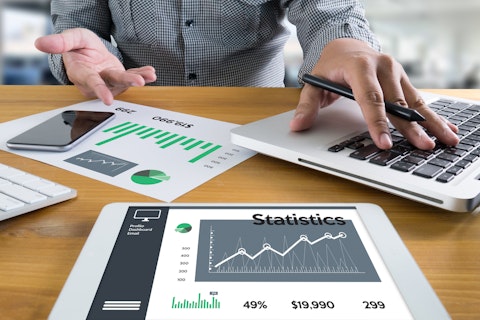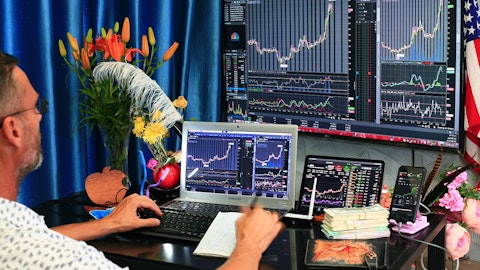The Trade Desk, Inc. (NASDAQ:TTD) Q2 2023 Earnings Call Transcript August 10, 2023
Operator: Greetings. Welcome to The Trade Desk Second Quarter 2023 Earnings Conference Call. [Operator Instructions] Please note, this conference is being recorded. I will now turn the conference over to your host, Chris Toth . Please proceed. Chris Toth. Please proceed.
Chris Toth: Thank you, operator. Hello, and good afternoon to everyone. Welcome to The Trade Desk second quarter 2023 earnings conference call. On the call today are Founder and CEO, Jeff Green; and Chief Financial Officer, Laura Schenkein. A copy of our earnings press release can be found on our website at thetradedesk.com in the Investor Relations section. Before we begin, I would like to remind you that except for historical information, some of the discussion and our responses in Q&A may contain forward-looking statements, which are dependent upon certain risks and uncertainties. These forward-looking statements represent our beliefs and assumptions only as of the date such statements are made. Actual results may vary significantly, and we expressly assume no obligations to update any of our forward-looking statements.

one photo/Shutterstock.com
Should any of our beliefs or assumptions prove to be incorrect, actual financial results could differ materially from our projections or those implied by these forward-looking statements. I encourage you to refer to the risk factors referenced in our press release and included in our most recent SEC filings. In addition to reporting our GAAP financial results, we present supplemental non-GAAP financial data. A reconciliation of the GAAP to non-GAAP measures can be found in our earnings press release. We believe that providing non-GAAP measures, combined with our GAAP results, provide a more meaningful representation of the company’s operational performance. With that, I will now turn the call over to Founder and CEO, Jeff Green. Jeff?
Jeff Green: Thanks, Chris, and thank you all for joining us today. As you’ve seen from our press release, we posted very strong growth in the second quarter. We reported revenue of $464 million growing 23% compared with last year. This also represents an acceleration in our growth rate compared with the first quarter. And just like the last few quarters, we continue to significantly outperform the digital advertising industry. What’s particularly notable about our performance is that most advertisers are still dealing with some degree of uncertainty in their business. Even though certain macro indicators are improving, there’s still a sense from many advertisers that we are in an unpredictable environment. For them, it’s hard to dismiss what we’ve been through over the last 2 to 3 years with the global pandemic, rampant inflation, supply chain crises and banking system uncertainty, and of course, global rebalancing.
None of these market dynamics have been very predictable the last few years. And this year, like the last few, has similarly had lots of never-before macro events. So while many indicators and advertiser sentiments are improving, there’s also a sense that it’s more difficult than ever to predict what’s coming next. But in this environment, marketers have learned that data-driven precision can bring a sense of certainty and reliability to their advertising efforts. Because of the innovations we brought to market in areas such as retail media, CTV, identity and data, advertisers have a clearer sense than ever of the performance and impact of their ad campaigns. And with Kokai, we are delivering even more innovation, all in service of helping advertisers drive precision, relevance and certainty in everything they do.
As a result, we are winning more business with both new and existing customers. We are signing more multiyear joint business plans, or JBPs, with leading agencies and brands representing spend projections in future years well into the billions of dollars. Our relative outperformance over the last few quarters means we have gained more market share than in any other period in our company’s history. Advertisers have become more deliberate with their spend and have increasingly gravitated to our platform and as they understand more about the power of programmatic, they are choosing the objectivity and performance of our platform over the murkiness of walled gardens more than ever before. Even as we continue to grow and scale around the world, we see no deviation from our 95%-plus retention rate.
Our clients rely on us more and more. I was at the Cannes Advertising Festival a few weeks ago, and I could have filled my calendar several times over with brand CMOs, agency leaders and CEOs of our key partners, all of whom want to understand how we can work more closely together. Every year, demand for the value that we deliver continues to grow. Perhaps what’s most interesting right now is how marketers are seeking a sense of certainty in an uncertain environment. Much of the product rollouts and partnership growth we’ve seen this year is because we’re giving our clients certainty and reliability that they can’t get elsewhere. This shows up all over our client base and all over our platform, but I’d like to talk today about a few places where the certainty and reliability is really driving our relative outperformance particularly in retail media, CTV and identity.
By discussing these 3, I believe it will provide some insight as to why we continue to outperform the market, why I believe we’ll continue to outperform the market and why we continue to invest in our platform with all the innovations coming from Kokai. So first, let me talk about retail media, which has become one of the fastest-growing areas of our business. Much like CTV, our rapid growth in retail media starts with our focus on objectivity. Retailers know we’re only here to serve advertisers and to drive more precision and efficacy in ad campaigns. We don’t compete with them. And like all of our partners, retailers know, we are careful and objective stewards of their data. As you know, Walmart was one of the first early major retailers to understand the power of their data and to help advertisers understand and measure the connection between campaign spend and actual consumer purchases.
For many advertisers, there’s no clear measurement of performance than that. You can look at all kinds of traditional marketing KPIs, but there’s nothing more powerful than knowing that a consumer bought your product because of the ad you serve and then using that data to improve marketing spend in the future. One of the great recent examples of this is Fruit of the Loom, working with our agency, GSD&M, Fruit of the Loom wanted to reach new and existing customers to increase sales with a back-to-school promotion. They were targeting a 200% return on ad spend, or ROAS, working with the Walmart DSP and The Trade Desk, they were able to predict audiences with much more precision and were able to understand in real time, how ads in different channels were performing.
They could then shift campaign dollars to those channels that were actually driving consumer purchases. This clear line of sight helps Fruit of the Loom vastly exceed their campaign goals, delivering a 1,200% return on ad spend among existing customers and more than 1,000% ROAS with new customers. Eric Mahoney is Fruit of the Loom’s Digital Marketing Manager. He said, and I quote, historically, we’ve done a really good job of reaching our brand purchasers. But working with the Walmart DSP allowed us to reach that new consumer through predictive audience segments. We could not have achieved these results without Walmart DSP and The Trade Desk.” He also said that working with The Trade Desk is like putting on a fresh pair of underwear. Of all the accolades we’ve received over the years that is definitely one of my favorites ever.
The gravitational pull of retail media is not limited to the U.S., retailers around the world are working with The Trade Desk in different ways to unleash the power of their data to help advertisers bring more value to their campaigns. In Singapore, we partnered with FairPrice, the largest grocery chain there with 570 stores serving 90% of the country’s population. One of the first brands to leverage FairPrice shopper data on our platform was Coca-Cola, who wanted to reach customers during the festive Lunar New Year season. They also wanted to be able to measure the performance of low-funnel marketing outreach across multiple channels, including OTT, audio, digital out-of-home and of course, open Internet display. The campaign tapped into FairPrice’s audience segments via our platform, targeting Fair-Price customers who had purchased Coke or other Coke products over the past 1 to 3 months.
They were able to target seasonal shoppers who purchased festive products and optimize in real time to the news and lifestyle channels that delivered the best results. With their agency, EssenceMediacom, Coke was able to drive 189% uplift in sales during the campaign. They were also able to measure consumer reaction in a range of new ways, including the time it takes for a consumer to buy a product following different kinds of ad exposures, audience engagement from different channels and cart values offirst time and repeat buyers. The retail media opportunity is also growing exponentially for us in Europe. In recent quarters, we’ve talked about our partnerships with leading retailers such as Ocado and Tesco. And just a few weeks ago, we announced a partnership with Europe’s largest retail group, Schwarz, which includes major brands such as Kaufland and Lidl.
From an advertising perspective, retail media is something that’s really taken off over the last 2 years. It’s no coincidence that the growing interest in retail media coincides with growing advertiser focus on authenticated ad environments. With retail media, advertisers can start with precise authenticated data whether that data is based on purchase history or loyalty data. From there, the advertiser can target based on what they know and then do more accurate data-driven modeling to expand targeting segments with greater precision Some of the same dynamics are behind the rapid growth of CTV advertising. As we have all seen in recent weeks, there is a ton of focus right now on the business model of TV. What is the future of the linear TV model?
And how does the TV industry create sustainable, profitable business models for streaming TV as viewers shift there in mass. I believe the answer will come in fully exploring the authenticated viewer data that sits at the core of the CTV ecosystem, which is something that today’s leading media companies are exploring. For the past couple of years, CTV has been one of our fastest-growing channels at scale. There are a range of reasons for that. Fundamentally, video remains the most effective way for brands to influence the hearts and minds of consumers. And with CTV, brands can apply data to their TV campaigns and measure with much more precision, the effectiveness of every ad dollar. And much like retail, advertisers value the authenticated audiences that come with CTV, pretty much every streaming TV viewer is logged in with an e-mail address.
For advertisers, this means more certainty. It also creates a new starting point centered on data. These dual forces of retail and CTV are truly bringing the power of data-driven decisioning home for advertisers, and it is accelerating their shift to programmatic on our platform. Whereas in the early years of programmatic, we were looking to find ways to affix data to campaigns. Today, we use data as a starting point for campaigns. Instead of hunting for ad opportunities with data, The Trade Desk and marketers are starting with data to know which media opportunities we should hunt for. It’s a different dynamic and it’s one that’s become more prominent as advertisers seek more certainty in an uncertain and unpredictable environment. As I said, media companies generally understand the value of authenticated user data.
And this is a major reason why the top streaming companies in the U.S. have pretty much all integrated with UID2 or are planning to. The latest was Warner Bros. Discovery, who announced at Cannes that they will integrate UID2 across all of their streaming properties, including Max and Discovery+. The broad embrace of UID2 across the CTV ecosystem has been driven in part by a key economic factor. Streaming leaders need to unleash the value of their authenticated data for advertisers in order to create as much precision and relevance as possible, thereby maximizing their CPMs. In order for the streaming business model to thrive and for media companies to keep pace in the content arms race, they need to maximize advertising revenue. As we have seen with every streaming platform launching an ad-supported service, a subscription based approach is not enough.
And the only way to maximize advertising revenue is to increase precision and relevance. With UID2, the advertiser can start with authenticated data, enrich that with their own and third-party data and then where they can find the right relevant audience, they will pay a meaningfully higher price. As Tim Sims outlined during our Investor Day, where advertisers are able to bid with certainty based on relevance and precision, the value of each impression increases significantly, generally, exponentially. Ultimately, this is how we will answer some of the vexing questions that have been swirling around the TV industry recently. And while we are still in the early days of the CTV advertising revolution, I’m confident that emerging innovations on our platform, such as a forward market for CTV advertising will only accelerate advertisers’ ability and appetite to fund this amazing new golden age of TV.
It’s also worth pointing out that this is an increasingly global trend. At Cannes this year, for example, we announced a new partnership with RTL, one of the largest pan-European media companies. Through this partnership, our international advertisers will have exclusive programmatic access to RTL’s addressable linear and connected TV inventory. We are starting with inventory across Germany, Spain, France and Austria with more European markets to follow soon. This represents our most significant step yet into the European CTV market. It’s also indicative of how the major European media companies are keeping pace with changing viewer preferences and advertiser demand to meet viewers where they are and where they are most leaned in. As many of you have seen, we had a lot to say about retail and CTV during our recent Kokai launch.
And I’d just like to take a moment to put that in perspective. Because as advertisers increasingly prioritize CTV and retail, it’s critical that we continue to innovate in our platform so that we surface value for our users as intuitively as possible. One way Kokai accomplishes this is with a series of new indexes or benchmarks that help advertisers understand and measure performance. In the retail arena, we launched the Retail Sales Index. The RSI helps advertisers understand the impact of their retail media spend across multiple retailers at once. In this way, we are massively reducing the complexity of measuring ad campaigns that run across multiple retail data sets. Now advertisers can understand which retail environments perform better at different times, in which channels, for which kinds of creatives, all in 1 place.
And in doing so, we are providing a level of objectivity and measurement from the bottom of the funnel all the way to the top, that is simply not possible within a walled garden. In addition to that, we also announced a few pioneering retailers who are making retail measurement available for free in our platform if the advertiser has activated their retail data for targeting. These retailers include Walgreens, Dollar General and Albertsons. This is a major step forward in bringing the full value of retail media to bear in service of greater precision and certainty. In the CTV space, we launched the TV Quality Index, or TVQI. As the CTV advertising market has multiplied in terms of inventory, there are some who would have you believe that a piece of user-generated content has the same quality in the eyes of the viewer as professionally produced content or live sports.
Yes, I know there are some UGC influencers who have millions of followers that some brands may target from time to time. But that’s a very small slice of UGC. The vast bulk of it is very unattractive, and sometimes even unsafe for brand advertisers. The TVQI helps advertisers understand the value of the impressions they are buying in the context of the quality of the content those impressions are served against. The index shows that for every 10-point improvement in quality there is a 15-point improvement in conversion rates. Sometimes it’s even higher than that. And for our own campaigns for The Trade Desk, in the second quarter of this year, as we were beta testing TVQI, we found that a 19-point increase in the index score resulted in a 50-point improvement in our conversion rate.
If you’re a marketing leader, these are substantial performance improvements. I mentioned those two elements of Kokai because they’re important to understand in the context of CTV and retailer as more advertisers gravitate to CTV and retail because they offer more certainty in starting advertising campaigns based on authenticated audience data, these Kokai innovations provide more certainty through the course of the campaign in terms of measurement and performance optimization. Of course, there are many other aspects of Kokai that we unveiled on 06/06, some of which are live and many of which we will be launching in the next few months. These indexes and other innovations, especially around the application of AI across our platform are helping us surface value more intuitively to advertisers.
We are revamping our UX so that the campaign setup and optimization experience is even more intuitive with data next to decisions at every step. And we’re making it easier than ever for thousands of data, inventory, measurement and media partners to integrate with us. In doing so, I believe that The Trade Desk will become an essential innovation hub of the open Internet. I’d like to end on this point because I think it’s important to reiterate that there are many things we do at The Trade Desk that are not in our immediate business interest. UID2, for example, is an innovation we devised about 3 years ago and promptly gave it away to the industry. We’re seeing broad adoption across the data and inventory ecosystems of the open Internet and accelerating use by advertisers.
In many ways, the industry is looking at innovations like UID2 as a core element of the flight to certainty that is driving a lot of advertiser action today. If an advertiser has certainty that they are reaching the right person across all channels, they will prioritize that ad buy. CTV and retail are major advancements in this regard, but UID2 is a major building block of this new cross-channel identity fabric too. This is particularly important as there has recently been a lot of speculation regarding the potential demise of third-party cookies in Chrome in early 2024. A lot of this speculation reminds me of the frenzy in 2017 when Safari deprecated cookies or more recently in 2021 when Apple made its IDFA changes. Each time I have stated that none of this will have a significant material effect on our business, and that was true.
I’ve said many times that I’m not sure that it’s in Google’s best interest to get rid of third party cookies because of the harmful impact it will likely have on publishers that have not implemented a strong identity strategy. But while it matters a lot to many browser-based publishers, in the long run, it really doesn’t matter that much to us. Advertisers will increasingly select ad opportunities where they can act with certainty and leverage their own data. That’s why I’ve spent so much time today talking about CTV, retail and UID2 as they have become essential building blocks of the open Internet. On the supply side, we developed OpenPath, to provide our clients with a direct transparent path to inventory. This is just the latest effort by the Trade Desk to improve supply-side transparency and objectivity and we now have thousands of destinations across the open Internet, integrating with OpenPath.
And when advertisers see an OpenPath channel to inventory, they are more likely to select it versus the 8 to 10 alternative paths to that same impression because there’s more certainty. And now integrating with UID2, OpenPath or any number of other innovations or offerings on our platform is easier than ever with Kokai. We believe that to truly optimize the value of the open Internet, there are many ways in which the industry needs to innovate together. So we can provide advertisers as an ecosystem with more certainty, transparency and objectivity. In recent weeks, we’ve heard even more about the alleged dubious behavior of walled gardens, whether it’s from the European Commission or independent research reports. Advertisers and media companies are increasingly aware that they need to work with technology partners who represent their interest, not conflicts of interest.
As a result, advertising dollars are shifting to our platform. And we will continue to invest in our platform and push the industry to create even more value for advertisers on the open Internet. Our recent outperformance is not a temporary blip, I believe it is the start of a reassessment of the value of the Internet, particularly from an advertiser’s perspective, and I could not be more excited about the growth opportunity that is in front of us in the years ahead as a result. And with that, I’ll hand it over to Laura to cover our financials.
Laura Schenkein: Thank you, Jeff, and good afternoon, everyone. For nearly the past 10 years, I’ve experienced firsthand all of the incredible work from The Trade Desk teams around the world that produce our outstanding performance that have enabled us to manage the right balance between strong growth and significant profitability. I’m proud to present our results today and going forward. With that, on to the numbers. As you’ve seen in our results, Q2 was a strong quarter. Revenue was $464 million, representing growth of 23% year-over-year, accelerating from the prior quarter. Excluding U.S. political election spend, which represented a low single-digit percent of spend in Q2 2022, our revenue growth rate in Q2 of this year was about 24.5% on a year-over-year basis.
Visibility and advertiser sentiment continued to improve throughout the quarter, and we continue to gain share as marketers increasingly focus their investments on areas where data is deployed effectively, where AI and decisioning produce high ROI and where results are measurable and transparent. Our growth continued to be driven by the shift of budgets to connected TV and increasing use of retail data. Because of our objectivity and our connectivity to nearly every major CTV content provider, our platform is the most eligible for the tidal wave of demand as it shifts away from linear and walled gardens. In retail media, many of the largest retailers around the world are now our partners and more and more brands and agencies are taking advantage of this powerful data in their campaigns.
We also continue to benefit from the trust we’ve built with our clients, launching innovative products in the interest of the demand side, paving cleaner path to supply and cultivating industry-wide support for improved identity solutions like UID2 and EUID. During the second quarter, growth was broad-based across channels, verticals and regions. CTV led our growth from a scaled channel perspective once again. We saw strong momentum again in retail media as we launched integrations with more retailers and won incremental shopper marketing budgets. International spend growth accelerated off a strong Q1 with notably strong performance in CTV. And with the launch of Kokai in early June, we are well positioned for the second half of the year and 2024 as visibility and advertiser sentiment improve.
With the strong top line performance in Q2, we generated approximately $180 million in adjusted EBITDA or about 39% of revenue. When we outperform on the top line, we often see that outperformance throughout all our financial statements as was the case again in Q2. This outperformance led to free cash flow of $119 million in Q2. Our unique ability to generate meaningfully positive EBITDA and cash flow continues to put us in a strong position as we look ahead and invest in the critical areas of the business that will drive our growth in the years to come. This is an area I’m intently focused on, making certain that our productivity and efficiency remains best-in-class as we scale as we manage both industry-leading growth and significant profitability.
I believe this is a critical factor to our success in the next phase of growth. From a scaled channel perspective, CTV, by a wide margin, led our growth again during the quarter. In Q2, video, which includes CTV represented a mid-40s percentage share of our business and continues to grow as a percentage of our mix. Mobile represented a mid-30s percentage share of spend during the quarter. Display continued to represent a low double-digit percent share of our business and audio represented around 5%. Geographically, North America represented about 88% of our business in Q2 and international represented about 12%. We are pleased that international Growth slightly outpaced North America for the second quarter in a row. Looking ahead, we see significant opportunities to capture share in international markets as operating conditions continue to improve.
In terms of the verticals that represent at least 1% of our spend, travel more than doubled compared with a year ago as the sector continues to recover. Automotive was strong once again with growth accelerating each month during the quarter due to share gains and recovery. We also saw strong performance in home and garden and food and beverage, while shopping and business were below the average. We continue to believe there is still opportunity for us to gain share in most of our verticals. Turning now to expenses. Excluding stock-based compensation, operating expenses in Q2 were $305 million, up 22% year-over-year. There are ample opportunities to achieve significantly more leverage within our operating expenses. However, our primary objective remains on growing spend on our platform and grabbing land.
During the second quarter, we continued to invest in our team, our platform and our infrastructure to support sustained growth. The year-over-year increase in operating expenses, excluding stock-based compensation, included realized costs from our 2022 hiring ramp, infrastructure investments and return to office expenses. Because we have responsibly managed headcount and operating expenses over the last few years, we’re in a strong position to continue innovating for clients, growing our teams and widening the distance between us and our competitors. Income tax expense was $27 million for the second quarter, driven primarily by our pre-tax profitability and nondeductible stock-based compensation. Adjusted net income was $139 million or $0.28 per fully diluted share.
Net cash provided by operating activities was $128 million for Q2 and free cash flow was $119 million. DSOs exiting the quarter were 92 days, up about 1 day from a year ago. DPOs were 76 days, up about 3 days from a year ago. In Q2 via our share repurchase program, we repurchased and retired 595,000 shares for an aggregate repurchase amount of $44 million. We exited the quarter with a strong cash and liquidity position. Cash, cash equivalents and short-term investments ended the quarter at $1.4 billion. We have no debt on the balance sheet. Turning to our outlook for the third quarter. While macro conditions remain uncertain, visibility has improved slightly since the beginning of the year. We estimate Q3 revenue to be at least $485 million, which would represent growth of 23% on a year-over-year basis.
Excluding U.S. political election spend, which represented a low single-digit percent of spend in Q3 2022, our estimated revenue growth rate in Q3 of this year would be about 25% on a year-over-year basis. We estimate adjusted EBITDA to be approximately $185 million in Q3. In closing, we’re extremely pleased with our strong performance in the first half of the year. I’ve always seen the immense opportunity this company has. And frankly, that opportunity has never been clearer than it is today. We have a large and growing addressable market in front of us. We have a business model that’s proven to generate strong top line growth in addition to significant profitability and cash flow. With growth drivers including CTV, retail media or international business, a strong identity strategy, a 2024 U.S. election year cycle, and a significant product upgrade with Kokai, among others, we remain highly optimistic about our future as we move through the second half of 2023 and into 2024.
That concludes our prepared remarks. And with that, operator, let’s open up the call for questions.
See also 10 Best Fast Growing Penny Stocks to Buy Now and 20 Most Popular Fast Food Restaurants In The World.
Q&A Session
Follow Trade Desk Inc. (NASDAQ:TTD)
Follow Trade Desk Inc. (NASDAQ:TTD)
Operator: [Operator Instructions] The first question comes from Shyam Patil from SIG.
Shyam Patil: Congrats on another strong performance. I had a 2-part question. First for Jeff, could you provide your thoughts on the macro and the current conditions and also your initial thoughts on next year, on 2024? And then Laura, can you talk about how you’re thinking about investments and expenses in the back half of this year, but also next year as well.
Jeff Green: Thanks for the question, Shyam. I’ll go first, and then I’ll just hand it over to Laura to talk about investments and expenses. So it’s not news to anybody here that the last 2 or 3 years have been a few years of uncertainty and unpredictability for most advertisers and most of the Fortune 500. As a result, I’m extremely excited by the change in sentiment that we’ve seen in Q2 and see already in Q3, where CMOs are doubling down on what’s driving growth there’s an understanding, of course, that the markets have begun to recover, and there’s more certainty than they’ve had in the past. But they’ve also come to rely on data-driven advertising during that time of uncertainty as a place for certainty and for results.
So we’re seeing lots of shifts due to what they’ve experienced in the last few years in CTV. And then, of course, this massive secular tailwind that comes from retail data as well. As I’ve said before, I believe ultimately, the shape of the Internet changes dramatically as a result of CTV and retail media. And then, of course, we’ve also seen some amazing results as a result of UID2 adoption. You might have caught during the prepared remarks that Warner Bros. was kind of the last of the U.S. independent CTV players to adopt UID2. So now, in a way, UID2 has the full collection here in the United States, and that has become the common currency to monetize CTV in the ad environment. We expect that trend to continue, and we’re seeing more and more of that.
For the second part of your question for me, 2024 is looking like the tidal wave of opportunity that is both daunting as well as just massive in terms of what an incredible chance this is for us to once again grab land. So let me first just talk about some of the backdrop for 2024. So there’s been a lot of pressure on Google over the last few years as it relates to antitrust as well as privacy. Of course, there’s a balance between those 2 that a few years ago, there was a lot more pressure on the privacy side of that. Today, there’s a lot more pressure on the antitrust side of that, which we think overall makes the market a bit more fair and makes it easier to predict Google’s decisions. It also makes it so that they are undoubtedly going slower and that creates opportunity for us to once again grab land.
I have said over and over again that linear television is not going to be a steady decline. It ends with an explosion. It’s going to have a pretty steady, then accelerating decay. And then there’s a point where it stops being worth it for anybody to operate in the space. You’ve kind of got a glimpse of this when Bob Iger was saying 3 weeks ago on CNBC, that he’s unsure about ABC’s future and their linear business model being broken, but of course, that streaming and the studios are very important to the future of the business. That business model is really talking about legacy linear and broadcast television and that, of course, the future is streaming. That represents one of the many opportunities for us in 2024. Now as our opportunity to demonstrate the power of decisioning, which is really what our brand new product release Kokai is all about.
We also have some major advances going into next year as it relates to the forward market. But when you add CTV retail media, Kokai, UID2, OpenPath, international opportunities, political, the list goes on and on. Of course, Disney announced today that they’ll roll out ad-supported models internationally for Disney+. We think that’s one of many opportunities around the world for us as it relates to CTV. So the secular tailwinds just keep piling up, but very excited about all that. I’ll turn it over to Laura to talk about investments and expenses.
Laura Schenkein: Thanks, Jeff, and Shyam, thanks for the question. In terms of our investments for the second half of 2023 and going into 2024, I’ll start off just the big picture and then get into the specifics of what we’re seeing. So just always remind myself that we’ve got the great luxury of high growth, profitability and cash flow. And we’ve been responsibly managing our headcount, OpEx growth and investments for many years now. So in the first half of 2023, we grew revenue in the 20% range. And we just guided to continued growth acceleration in revenue when you exclude U.S. election spend that we saw in the same period in 2022. So from my perspective, we’re in an enviable position, while many of our other peers have struggled.
So when I look out at the rest of 2023, I just look at how we’re being very deliberate in our investments and in our hiring, and we still expect headcount to grow this year, but roughly at half the rate of last year, which implies around 20%. And that sets us up very nicely for 2024, just as I remind everyone that our people are our largest area of investment. We’re also investing heavily into our platform and our products, specifically in areas like CTV and our forward market product and in retail media. And as we’re doing this, we’re focusing heavily on productivity and efficiency with all of our teams from our engineering teams to our go-to-market, business, sales AM and trading teams to make sure that we believe that all of our teams are firing on all cylinders.




